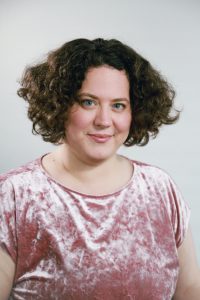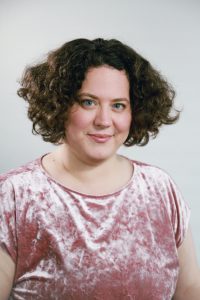A Community within a Community
This month’s blog post is by Lauren Schreiber Sasaki, who is investing in 
An interfaith family walks into a shul. Or a JCC. Or any other Jewish space.
The flyer, poster, sign reads: “The door is open, and everyone is welcome.”
But what does that really mean?
They wonder – when you address the room, will you be speaking to Jews only? Will you use Hebrew words, and not translate them, so that they are a secret code only one of us can hear? Will you use Yiddish, and not explain your inside joke? Will you marry us? Can we both be members? Can we stand at the bima, together, when our children come of age? Are we Jewish enough? Do we count? Do I count?
I look around the room at my JCC, and in other spaces in the larger Jewish community, and I wonder if I am alone. It is only through whispers that my kehilla within a kehilla, my community that is part of this larger community, the other multifaith, multiracial and multicultural Jews, are pointed out to me.
“That family – he’s Jewish, she’s not”. It is discovered in casual conversations, the ones where we make assumptions about one another, and are then corrected – “Actually no, I’m not, but my family is”. Each time, there is a sigh of relief – I am not alone, we are not the only ones. There are so many of us. At every Shabbat dinner, every holiday celebration, in every space, really. So many of us, finding our way to each other, looking for recognition. Looking for affirmation – we belong here. This is ours. We count.
I suggest that it is the approach to intermarriage, rather than intermarriage itself, that creates the tenuous relationships to Judaism described by Rabbi Sid in his essay. I suggest that altering our approach and creating an explicit kehilla (community) for these families can create opportunities to develop deep, meaningful Jewish identities for future generations.
I want to be together, with my Jewish community. My Jewish community that navigates the same tricky roads, that needs the same support I do, that finds joy in weaving together cultures to create uniquely ours, something beautiful and new. New and Jewish. Jewish And.
Jewish& is creating space where people can purposefully come to the table with everything that they are. Where they feel seen, acknowledged and supported. Where they can learn from each other, and with each other. Where they can explore new ground, the infinite iterations of what a Jewish family can be. Where they can celebrate, Jewishly, together. And where the place that they are on their Jewish journey does not determine where they can go. And though I am the staff person developing Jewish &, to be clear, I am also, one of “them”.
In the fall of 2019, The Miles Nadal JCC in Downtown Toronto launched Jewish&, a program that explicitly gathers multi-faith and multi-cultural individuals, couples and families for Jewish exploration, education and celebration. The program has had atremendous impact. We started the programmatic year with a Family Crafternoon for Rosh Hashanah. We ate apples & honey, and made calendars with all the Jewish holiday dates. When folks arrived, they were invited to make a nametag with their name and the answer to a community question: – What is your favorite holiday? People had every answer you could imagine: Chanukah and Purim and Shabbat, but also Easter and Thanksgiving and Halloween and My Birthday. Of course, many people also said Christmas.
Later in the day, a parent whose kid had listed Christmas as their favorite holiday, came up to me and shared the following: “If I had been in any other Jewish space, at any other Jewish event, and my kid had been asked their favorite holiday, and they had said CHRISTMAS, I would have felt embarrassed, and I probably would have tried to coerce them to choose something else. This is the first time we’ve been able to show up as exactly who we are, not play down any part of ourselves, and the fact that we celebrate or even enjoy Christmas doesn’t make us any less of a Jewish family.”
We held a December Dilemma photo shoot, where twenty families came and sat for a beautiful family portrait taken with a neutral backdrop, which they were then able to put in a card and send to Savta and Grandma, without any hurt feelings.
We held a Shabbat Dinner, “hosted” by a wonderful couple—one partner Ashkenazi and the other Vietnamese— at a Vietnamese restaurant, where they shared their story with us before blessings and a meal. They spoke to the table about their marriage of 20 years, raising their Jewitnamese daughter, and how, despite considerable involvement in Jewish communal life, the non-Jewish partner still felt like an outsider. At best, they felt invited to partake of Judaism, but with an implicit assumption that part of their own culture of origin was better left outside of the frame.
We have held Challah Hangs, where we wove together our cultures like braided dough. Jewish& Scottish Chef, Jennifer Crawford, shared their story of the late in life discovery that their father had been Jewish, and taught us how to make Scottish Brown Bread in the style of Challah for Shabbat. At that event, we learned from them, and they learned from us – that their comically large Challah was made from dough really meant to be two loaves, but how would they have known that? That reciprocal communal learning was bonding, and binding.
When a community member responds publicly to an event, “Thank you. I feel seen”, I know that we at the beginning of something important.
I believe that intermarriage does not mean the end. I believe the door closes when we decide to close it, when people are told, with words and actions, that they are a fraction of a thing. When Jewishness is quantified, we are told that we do not count. When Jewishness is qualified, we are told that we aren’t enough. However, when we are taken as we are, and space is created for opportunity, discovery, and growth, anything is possible. With trust in place, we can come to the table, wholly ourselves.
[themify_hr color=”light-gray” width=”100%”]
Lauren Schreiber Sasaki is a Montreal-born, Toronto-based arts and culture programmer who, having worked in the music and theatre worlds for the last 15 years, recently turned her focus to Jewish community. She is excited to be leaning in to her roots while investing in her community, and raising multi-racial, multi-cultural and multi-faith kids with her partner in Canada’s largest urban center.


